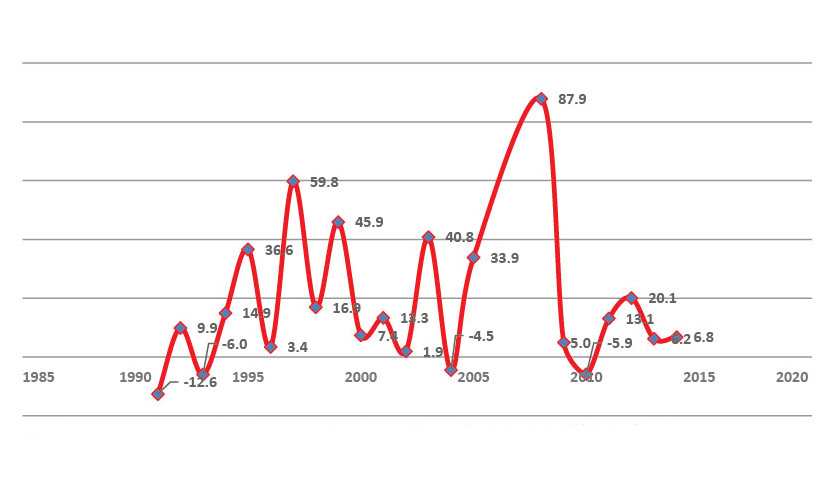Published in ICE Business Time on Monday, 3 October 2016
Training the Future- Towfiqul Islam Khan
 Skills, knowledge, and innovations are the key driving forces of economic growth and social development of a country. Empirically, countries with higher levels of education and skills can respond effectively to challenges and opportunities in the global economy. The skill development of the youth has been emphasized in Goal 3 of Education for All (EFA), a global movement led by the United Nation Educational, Scientific and Cultural Organization (UNESCO). No wonder that the sustainable development goal (SDG) 4 has two targets related to developing technical skills. Viz. by 2030, to ensure equal access for all women and men, affordable and quality technical, vocational and tertiary education. The aim, by 2030, is to substantially increase the number of youth and adults who have relevant skills, including technical and vocational skills, required for employment in decent jobs, and entrepreneurship. These targets are particularly relevant for Bangladesh as the country is dire need to convert the ‘demographic window of opportunity’ to ‘demographic dividends’. With large cohorts in Bangladesh preparing to enter the workforce and smaller cohorts coming behind, there is a special need to improve the quality and quantity of education and skills training more quickly. The large groups of Bangladeshi children and youth that will enter the labor force over the next decade will make up a large proportion of the workforce for decades to come. In contrast, Global Competitiveness Report (GCR) 2016-17 identified inadequacy of educated and skilled workforce as one of the constraints for doing business in Bangladesh. Indeed, the manufacturing sector which recorded double-digit growth on an average over the last one decade still suffers from skilled workers and has to obtain for on-the-job-training.
Skills, knowledge, and innovations are the key driving forces of economic growth and social development of a country. Empirically, countries with higher levels of education and skills can respond effectively to challenges and opportunities in the global economy. The skill development of the youth has been emphasized in Goal 3 of Education for All (EFA), a global movement led by the United Nation Educational, Scientific and Cultural Organization (UNESCO). No wonder that the sustainable development goal (SDG) 4 has two targets related to developing technical skills. Viz. by 2030, to ensure equal access for all women and men, affordable and quality technical, vocational and tertiary education. The aim, by 2030, is to substantially increase the number of youth and adults who have relevant skills, including technical and vocational skills, required for employment in decent jobs, and entrepreneurship. These targets are particularly relevant for Bangladesh as the country is dire need to convert the ‘demographic window of opportunity’ to ‘demographic dividends’. With large cohorts in Bangladesh preparing to enter the workforce and smaller cohorts coming behind, there is a special need to improve the quality and quantity of education and skills training more quickly. The large groups of Bangladeshi children and youth that will enter the labor force over the next decade will make up a large proportion of the workforce for decades to come. In contrast, Global Competitiveness Report (GCR) 2016-17 identified inadequacy of educated and skilled workforce as one of the constraints for doing business in Bangladesh. Indeed, the manufacturing sector which recorded double-digit growth on an average over the last one decade still suffers from skilled workers and has to obtain for on-the-job-training.
In response to the emerging needs, both in view of the domestic as well as anticipated global market demands, Government of Bangladesh (GoB) has adopted five different current plans or policy statements involving technical and vocational education and training (TVET), notably the Education Policy 2010 and the National Skills Development Policy 2011. Besides, the Seventh Five Year Plan (7FYP) proposes priorities and strategies for education including skill development. The main elements of the skill development strategy in the 7FYP include:
- Diversification of technical and vocational education programs to meet the technical manpower needs in the areas of emerging technologies, such as: Fish Production, Leather, Textile, Mechatronics, Mining & Mine Survey, Instrumentation & Process Control, Construction, Environmental, Garments Design & Pattern Making, Electro-Medical, IT sector etc.;
- Encouraging more women’s participation in TVET to ensure empowerment, equality and gender equity;
- Development and modernization of existing TVET Institutions with available rural technologies to meet the challenges of the fast changing economy in the rural setting for poverty alleviation and to arrest rural-urban migration.
The plan also aims to encourage private sector involvement and initiative in the delivery of technical and vocational education programs. Indeed, these documents emphasized the need for developing skills and capacities of young people to enable them to respond effectively to the employment market in the country and the opportunities in the global economy. Also, these policies have a gender equality plan and a plan for people with disabilities.
Historically, the linkage between the TVET system and private industry has been relatively weak, making it difficult for the system to adequately supply the skills demanded in the job market. Regrettably, the conventional sectorized and fragmented approach to government operations and policy making have limited the possibility of a comprehensive and coordinated approach towards skills development in Bangladesh. In Bangladesh, formal TVET up only a tiny portion of secondary education, and evidence suggests that some TVET resources are underutilized because of low demand from students. In contrast, many of the rapidly developing countries and recently developed countries of Asia made TVET a central focus of their education systems as a way of preparing for rapid industrialization. The growth rate of the students enrolled in TVET has been highly volatile. Even though the number of students has been increasing over the years, the proportion of students enrolled in TVET as a percentage of all students is very low and quite unsatisfactory. The proportion increased from 0.4% in 2001 to only 1.8% in 2013. The global average for proportion of secondary school people enrolled in skills development programs in the year 2010 was 11%. However, this average figure reflects a high regional variation. The figures for Central Asia, East Asia and Pacific, and Central and Eastern Europe ranged between 17% and 20%. However, in South and West Asia, the corresponding figure was less than 2%. Within this lowest performing region, Bangladesh’s performance is not praiseworthy.
Growth of enrolment in TVET (%)

Source: Author’s calculation from Bangladesh Bureau of Educational Information & Statistics (BANBEIS) data.
Inadequate physical infrastructure is a major concern for expanding quality TVET which acts as a barrier to participation for skills development training. Deficiencies in basic facilities, teaching-learning materials, and basic amenities, ineffective teaching-learning practices and styles were reported as other potent barriers to the effectiveness of the TVET courses. Empirically, it has been found that rural young people were facing the problem more than their urban counterparts. Girls in both rural and urban areas are suffering more compared to the boys.
The government’s recent efforts to promote participation in TVET merits appreciation. A number of projects which have undertaken to promote TVET also increased during this time period. However, both allocation and type of training are still inadequate against the market demand. It is observed that the types of training provided under the programs often do not correspond to the rising demand for skilled labor, particularly for the growing manufacturing sector of the country. This success can be attributed to the distribution of resources for this sector. Allocation for promoting TVET and skill development increased from Tk 165 crore in RBFY2012 to Tk. 441 crore in RBFY2016 – nearly a 167% increase in five years. In line with the enrollment figures, expenditures for TVET accounted for about 2.6% of the total education budget. However, the targets regarding establishing new TVET institutions in underserved areas and introducing emerging trade and technology courses by modernizing curriculum were not reached during the recent years.
In general, the present level of budgetary allocation for education in Bangladesh is, by any standard, well below than what is required. The share of the education sector budget has declined over the recent years, both as a percentage of Gross Domestic Product (GDP) and as a share of the total budget. The share of the education budget as a proportion of the total budget decreased to 11.6% in FY2016 from 15.9% in FY2007. According to World Development Indicator (WDI) data, Bangladesh, with an education budget to the tune of 1.9% of GDP, has been ranked 155 out of 161 countries in the world. In all other South Asian countries, the corresponding figures are higher (Afghanistan: 4.6%, Bhutan: 5.6%, Nepal: 4.1%, India: 3.9%, and Pakistan: 2.5%). Indeed, the figure has remained around 2% of GDP for the last 14 years. The national education budget for FY2017 has made an effort to correct the course, however, it needs to consider that much of the rise accounts for a salary increase for government employees. While such an increase in salary for teachers was required, it can hardly ensure more and better services.
Education budget as a share of GDP (%)

Source: Author’s compilation from World Development Indicators (WDI) data.
Utilization of allocated scarce resources for education falls short of the needed level. It was also found that government agencies responsible for implementing the budget for education are often not being able to fully utilize their respective allocations. It is critically important to invest in TVET on a priority basis. Taking the rising demand for skilled workers in both domestic and global markets into cognizance, more investment for TVET has to be a top priority. TVET policy will also need to consider the required self-employment skills, as also types of skills required for Bangladesh’s growing manufacturing sector. Hence, the TVET policy and its finances need to take cognizance of other relevant macroeconomic policies including trade and industry policies of Bangladesh. Expanding the number of ‘Centers of Excellence’, which are currently established in the leather, agro-food, tourism, and RMG industries to provide specific industry-centered training initiatives, should be encouraged. This can only be successful with a mix of private sector, donor, and government funding.
iThe writer is a Research Fellow at the Centre for Policy Dialogue (CPD). He can reached at: towfiq.khan@gmail.com. The views of this article do not necessarily reflect the views of the aforesaid organization.



